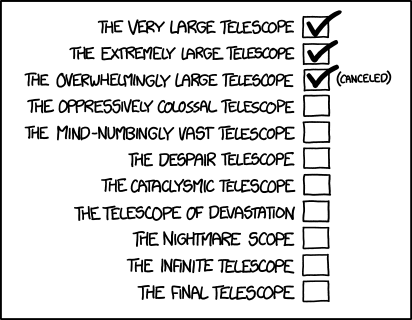Tag archives: astrobiology
Feedback on a scheme to cloak Earth from hostile aliens

David Kipping doesn’t want to hide from aliens.
By Hamish Johnston at the APS April Meeting in Salt Lake City
Earlier today I caught up with David Kipping of Columbia University in the US after his fascinating talk about what could make an exoplanet habitable. I wanted to ask Kipping about a quirky paper that he and Alex Teachey published a few weeks ago, which I wrote about in the The Red Folder.
Kipping and Teachey described how a laser could be used to cloak the Earth from the prying eyes of an extraterrestrial civilization. The paper was published just before 1 April, so at the time I wasn’t sure whether the paper was legitimate (it is) and Kipping told me that publishing before April Fools’ Day did cause some confusion.
So what feedback has Kipping had about the paper?
Twin alien civilizations, the ancient genetics of cancer, and marvellous Maxwell and his wonderful equations
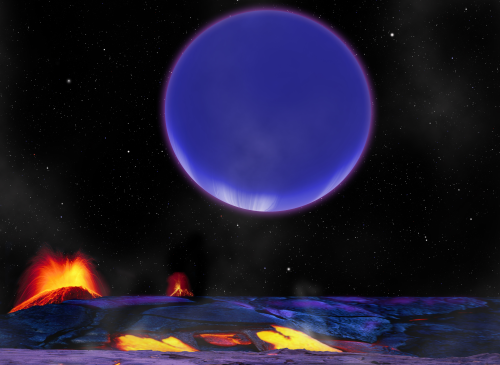
It’s raining life: could two nearby planets exchange living organisms? An artist’s impression of one planet in the Kepler 36 system as seen by its neighbour.
(Courtesy: Harvard-Smithsonian Center for Astrophysics/David Aguilar)
By Hamish Johnston and James Dacey
There is an intriguing article about alien life this week in The Conversation. “Twin civilizations? How life on an exoplanet could spread to its neighbour” is by David Rothery of the Open University and is a popular account of a paper that will soon be published in the Astrophysical Journal. The paper is inspired by the star Kepler 36, which has two planets that are in very close proximity to each other. While the Kepler 36 worlds are not suitable for life, the paper’s authors – Jason Steffen and Gongjie Li – explore possible exchanges of life between two Earth-like planets in similarly close orbits. Rothery explains that debris flung off one of the planets would stand a good chance of finding its way to the surface of the other planet after a relatively brief journey through space.
Radiation blasts render Earth’s twin inhospitable to life
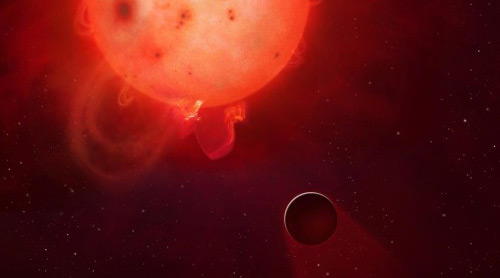
Radioactive? Kepler-438b is regularly irradiated by huge flares of radiation from its host star. (Courtesy: Mark A Garlick/University of Warwick)
By Tushna Commissariat
In the past decade or two, exoplanetary research has been booming as NASA’s Kepler telescope and its cohorts have found nearly 2000 exoplanets and 5000 promising candidates. Unsurprisingly, we have been searching long and hard for those planets that could be habitable or are as similar in shape, size and proximity to the host star as the Earth is to the Sun. Indeed, in January this year Kepler scientists announced that they had found the most Earth-like planet to date – Kepler-438b – orbiting within the habitable zone of its host star, the red dwarf Kepler-438, which lies about 470 light-years from Earth.
The planet, which is slightly bigger than our own, was found to be rocky, and, thanks to its location, rather temperate, meaning that it could have flowing water on it – two key factors that astronomers look for when accessing a planet’s habitability. Unfortunately, David Armstrong of the University of Warwick in the UK and colleagues have now found that Earth’s twin is regularly bathed in vast quantities of radiation from its star – a real dampener when it comes to the formation of life as we known it.
View all posts by this author | View this author's profile
Going underground to discuss alien life
By James Dacey
“Genuinely, it could be our generation that first finds life on another planet,” declared astrobiologist Lewis Dartnell last Thursday during a public talk in London. Dartnell was speaking about the possibility of life beyond Earth and what those organisms might be, based on our understanding of life here on Earth. The choice of venue – a pedestrian tunnel near King’s Cross Station bathed in neon lights – brought an appropriate alien vibe to the evening. Part of the reason for choosing the site is because if humans were to one day colonize Mars we would need to spend the first few years living underground to avoid the lethal radiation.
The search for alien life gathers pace
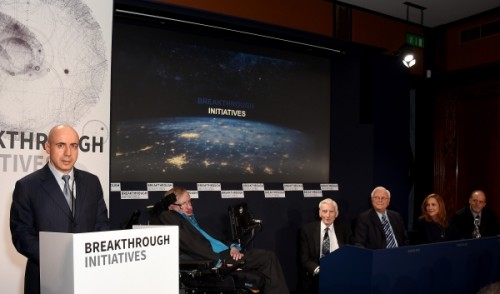
Alien hunters: Yuri Milner (left) and friends announce the Breakthrough Initiatives. (Courtesy: Breakthrough Initiatives)
By Hamish Johnston
Earlier this week in London the billionaire physics enthusiast Yuri Milner joined forces with some of the biggest names in astronomy and astrophysics to announce a $100m initiative to search for signs of intelligent life on planets other than Earth. The money will be used to buy time on a number of telescopes to search for radio and optical signals created by alien civilizations.
View all posts by this author | View this author's profile
Working at the interface of physics and biology
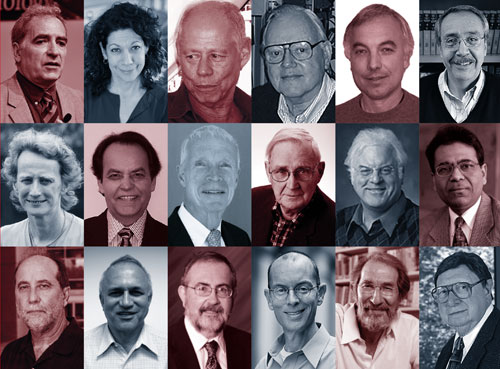
Face to face at the interface between physics and biology.
By Michael Bishop
In the 60 years since James Watson and Francis Crick brought physics and biology together to unveil the molecular structure of DNA, the boundary between the two disciplines has continued to become increasingly blurred.
In this post-genomic era, ever more principles from physics have been applied to living systems in an attempt to understand complexity at all levels.
Yet cultural differences still exist between physicists and biologists, as is made clear in a set of excellent perspectives in the journal Physical Biology, published by IOP Publishing, which also publishes Physics World.
In “Perspectives on working at the physics–biology interface”, a group of eminent scientists give their accounts of working at the interface of physics and biology, describing the opportunities that have presented themselves and outlining some of the problems that they continue to face when working across two fields with quite different traditions.
View all posts by this author | View this author's profile
Earth’s cousin, alien intelligence, Galileo’s game and more
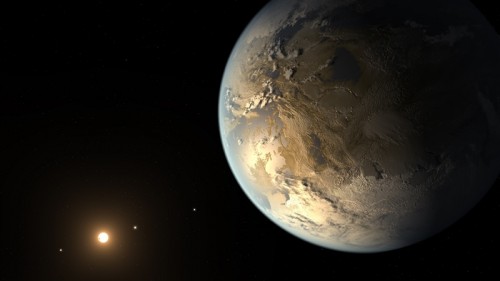
Artist’s illustration of Kepler-186f. (Courtesy: NASA/SETI Institute/JPL-Caltech)
By Tushna Commissariat
Early last week, astronomers announced that they had found the first Earth-sized exoplanet that is comfortably within the habitable zone of its parent star, using NASA’s Kepler telescope. The new planet, dubbed Kepler-186f, is a close cousin of the Earth as it has a radius that is only 10% larger than that of the Earth, meaning that it could have liquid water on its surface, allowing for the tantalizing possibility of some form of life to exist upon it. At last count, Kepler has now discovered and confirmed 1706 exoplanets.
So it was rather interesting to come across two stories that looked at the implications of life beyond our planetary neighbourhood. Paul Gilster, who writes the Centauri Dreams blog had a rather interesting post on how artists and illustrators need to work with scientists to depict each new exoplanet, to make the images look visually stunning, while still being scientifically accurate. Gilster also talks specifically about the image (see above) that illustrates the newly found Kepler-186f.
View all posts by this author | View this author's profile
Life on Mars?
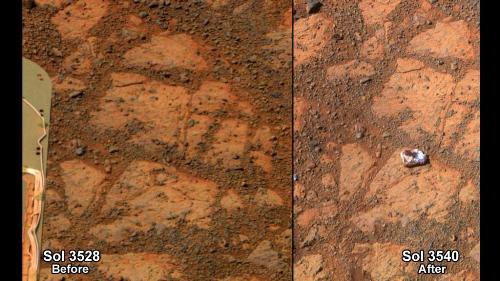
Magic mushroom? (Courtesy: NASA)
By Michael Banks
You may remember the story of Walter Wagner, the Hawaii resident who set his sights on stopping CERN’s Large Hadron Collider (LHC).
Wagner, together with his colleague Luis Sancho, filed a federal lawsuit in the US District Court in Honolulu in 2008 to prevent the LHC from starting up. In the lawsuit, Wagner and Sancho claimed that if the LHC were switched on, then the Earth would eventually fall into a growing micro black hole, thus converting our planet into a medium-sized black hole, around which the Moon, artificial satellites and the International Space Station would orbit.
View all posts by this author | View this author's profile
Safe graphene, Martian mollycoddling, mathematical tales and more
By Tushna Commissariat
Just when we thought that it couldn’t possibly have any more practical applications, everybody’s favourite “wonder material” graphene is going to be used to develop “stronger, safer, and more desirable condoms”. Thanks to a Grand Challenges Explorations grant of £62,123 from the Bill and Melinda Gates Foundation, scientists at the University of Manchester will use graphene to develop new “composite nanomaterials for next-generation condoms, containing graphene”. Unsurprisingly, the story made all the national newspapers with the BBC, the Guardian, the Telegraph and the Independent all having their say. The Guardian also noted that industrial graphene-producer Applied Graphene Materials’ shares jumped by 40% during its stock-market debut, the day before the above story broke. You can read more about graphene’s many potential applications on page 50 of Physics World’s anniversary issue, a free PDF download of which is available here.
View all posts by this author | View this author's profile
Extending the ‘Goldilocks’ zone
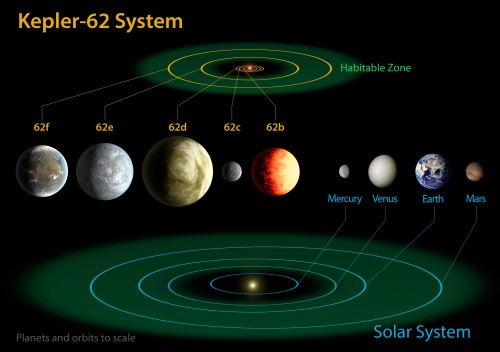
A comparison of the inner planets of our solar system, within the habitable zone, to Kepler-62 – a five-planet system about 1200 light-years from Earth. (Courtesy: NASA/Ames/JPL-Caltech)
By Ian Randall
In the modish hunt for exoplanets, the holy grail is discovering such a body within the habitable zone of a star – offering a tantalizing potential for extraterrestrial life. If our solar system is anything to go by, we can expect most planets to form outside of the confines of this zone. What if, however, the habitable zone is really larger than we thought?
This is the idea put forward by Sean McMahon from the University of Aberdeen, Scotland, and colleagues in a recent paper – proposing that the existing definition of the habitable zone overlooks the potential for life to survive below the surface of terrestrial planets that currently lie outside the zone’s reach.
View all posts by this author | View this author's profile
